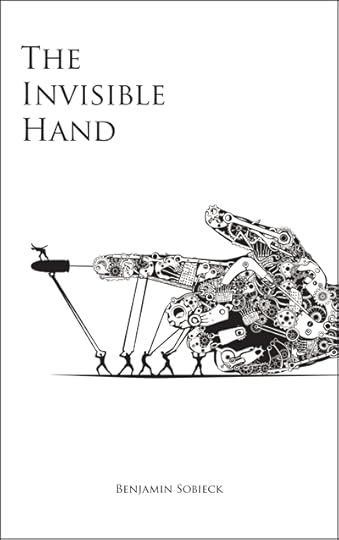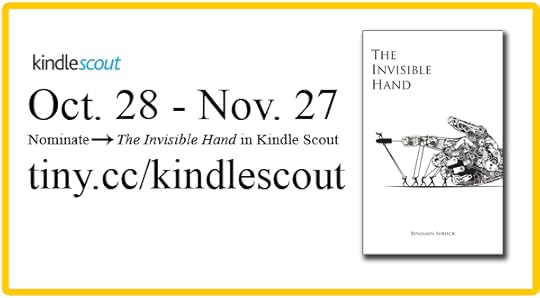Benjamin Sobieck's Blog, page 20
October 28, 2014
Kindle Scout - Your Help Needed
Hey hey, it's Kindle Scout campaign time. I'm asking you to do three things for me:
Go to the Kindle Scout campaign page for my crime novel, The Invisible HandSign up as a Kindle Scout reader if you haven't already (it's free, you just use your normal Amazon account)Nominate The Invisible Hand
By nominating my novel, you've giving me a shot at an Amazon publishing contract. If I wind up with one, you'll not only have helped make the day of this writer guy, you'll get the e-book on the house once it's published.
This campaign means a lot to me. I hope you'll click here to get started.
P.S. Let me know about your experience going through the nominating process, I'm curious. Leave me a comment below.
October 27, 2014
My Kindle Scout Campaign Launches Tomorrow
Tomorrow will mark the start of the Kindle Scout campaign for my crime novel, The Invisible Hand. Even though it's early, Amazon provided me with a link that will work on this thing starts. If you don't mind, bookmark this page.
Here's what I need you to do tomorrow. Go to this link, check out my book and nominate me. Doing so will put me a step closer toward a real-deal Amazon publishing contract. If I do wind up with the contract, Amazon will shoot you a free copy of the e-book once it's published.
For those unfamiliar with Kindle Scout, check out the website to see how it works. You can also read my journey up to this point here.
Thank you,
Ben
P.S. Check out The Digital Reader's preview of Kindle Scout from a reader's perspective. Interesting insights.
October 25, 2014
When a Firearm Is Not the Most Deadly Weapon
Didn’t want you writer folks to miss out on this article by Massad Ayoob over at GunDigest.com, The Dangerous Myth of Hierarchy of Lethality. Ayoob, one of the world’s foremost authorities on firearms and self-defense, details the situations where a firearm is not the most deadly weapon on the scene. Although his article his aimed at the gun crowd, there’s plenty in here to think about for writing.
For example:
A full-size automobile traveling fifty miles an hour generates approximately half a million foot-pounds of energy. Far from being unarmed, the violent man who turns his automobile into a guided missile has armed himself with the most crushingly powerful of bludgeons.
And:
A knife never jams. A knife never runs out of ammunition; you rarely see a gunshot murder victim who has been shot more than a few times, but any homicide investigator can tell you how common it is for the victim of a knife murder to bear twenty, thirty, or more stab and/or slash wounds. “A knife comes with a built-in silencer.”
Check out the full article here.
Don’t forget to sign up for my free e-newsletter, too.
October 24, 2014
Writing Knives: What are Blood Grooves?
“Blood grooves” sure do sound cool, don’t they? The term is a hair away from “gore trench,” "kill ditch" or “splatter line.” All of these would make for fine garage band names, but we’re talking about knives here. And that’s why I need to clear something up about blood grooves.
Blood grooves consist of a long depression cut into a blade. Here’s an example.
[image error]
It’s said blood grooves channel fluids away or reduce suction when the blade is removed from flesh (or, more likely for most people, watermelons). I got news for you. Gravity takes care of fluids and suction is going to happen anyway.
Instead, blood grooves are worked into a blade to reduce its weight without sacrificing length. This helps a knifemaker or designer achieve better balance. Blood grooves may also be used for looks, since people think they’re badass.
Well, there’s nothing badass about the technical name for blood grooves, “fullers.” Snooze. Sword makers originally used fullers for balance before the technique was imported into knives.
I’ve only read a few instances from novels where blood grooves are mentioned. If you decide to do the same when writing, just keep in mind their only practical purposes are balance and aesthetics.
If you enjoyed this article, please sign up for my free e-newsletter.
October 23, 2014
On Tang and Choosing a Knife for a Character
 Ah, the crisp, refreshing zing of a cold glass of Tang. Is there anything better than that in the morning? Can’t kick things off without an astronomical dose of orange-ish vitamin C.
Ah, the crisp, refreshing zing of a cold glass of Tang. Is there anything better than that in the morning? Can’t kick things off without an astronomical dose of orange-ish vitamin C.
Wait, we’re talking about knives? In that case, stop drinking Tang (uppercase T) and start thinking tang (lowercase t).
A knife’s tang is an important feature to consider whenever assigning a character a hard-use blade. By that I mean the kind of knife slated for a workout slashing and slicing its way through a story.
This is important since these oft-appearing knives can become a signature piece of a character’s ensemble. Who’s Rambo without that Jimmy Lile custom knife? Would Michael Myers (right, image via Wikipedia) carry anything other than a butcher knife in the Halloween movies? Would Heath Ledger’s Joker in The Dark Knight be as creepy without that knife fetish?
Before choosing a knife for your character on looks or “cool factor” alone, first consider the tang.
The tang is the part of the blade that runs down into the handle to offset pressure during use. The longer the tang, the more durable the knife. When the tang runs all the way down the handle, it’s referred to as a “full tang.” If the tang is short or reduced, it’s referred to as a “partial tang,” “half tang,” “rat-tail tang” or “push tang.”
Here’s what I mean.
[image error]
[image error]
[image error]
Full tang knives by far can take the most beating. When you’re researching a specific knife model for a character, keep an eye out for “full tang,” “long tang” or something close to that. In all cases, full tang knives are “fixed blade,” meaning the blade doesn’t move as it would with a folding knife.
Why does this even matter? Because partial tang and folding knives (i.e. switchblades/automatic knives, pocketknives, assisted opening knives, etc.) can’t hold up to extreme conditions in the way fixed blade, full-tang knives can. In my book, Weapons for Writers: A Practical Reference for Using Firearms and Knives in Fiction, I detail a true story from crime writer Les Edgerton about a switchblade used in a violent encounter. A woman used the switchblade to stab another person. The blade, because it didn’t have a tang, bent and would not go back into the handle. The knife failed.
That doesn’t lend itself well to the rigors of fiction, where knives can be put through any number of hard-use scenarios. In those cases, a fixed blade, full-tang knife is the way to go.
Here are a few go-to models and types I think could be used in almost any story.
KA-BAR USMC (classic) SOG SEAL Team (modern) ESEE-6 (tough as hell) CRKT Ultima (cool design) Buck Hoodlum (damn) Ontario Knife Company Black Bird SK-5 Noir (plain Jane) A generic Bowie knife (a style of knife that looks like this) A generic kitchen knife (butcher, cleaver, etc.) with a full tang
What kinds of knives are you giving to your characters?
If you enjoyed this article, be sure to sign up for my free newsletter.
October 22, 2014
7 Reasons Why I Submitted to Kindle Scout
The Digital Reader was kind enough to host a guest blog post from me on why I choose to submit my crime novel, The Invisible Hand, to the Kindle Scout program. Writer folks, this is one you'll want to check out. Let my manuscript be your guinea pig.
Click here to go to The Digital Reader.
Also, here's the cover for the novel. Figured I should toss that up while I'm at it. Yeah, that's a guy surfing on a handgun cartridge. Deal with it.

The Kindle Scout Adventure Continues
Looks like this grand Kindle Scout experiment is attracting a little bit of attention. The Digital Reader picked up my post from yesterday and did a write up here. Check it out for some perspectives on this adventure from its editor, Nate Hoffelder.
October 21, 2014
Coming Soon: Kindle Scout Campaign for My Crime Novel
I submitted my latest crime novel, The Invisible Hand, to the Kindle Scout program yesterday. Kindle Scout, a new program from Amazon, is only a week old, and seemed like a good option considering everything else going on at home (i.e. prepping for our first kid to arrive later this year - holy crap, I still can't believe that's happening). Well, what do you know, Amazon got back to me in less than 24 hours. My campaign is to start on Oct. 28 and run for 30 days.
For those not in the know, Kindle Scout is Amazon's dual attempt at crowdsourcing and putting some reins on the whirlpool that is KDP (Kindle Direct Publishing). A writer submits a completed manuscript, cover and description. The Kindle Scout people review the content, then decide if it's accepted into the program. If it is, the book gets a campaign page where "scouts" (aka readers) can nominate the title over a 30-day time period. Books with the most nominations, as well as potential in the eyes of the Kindle Scout team, will go on to get published by something called Kindle Press. There's a legit advance and five-year publishing contract attached to that.
Writers can see the specifics of how this works here, but I won't bore anyone with that. I wanted to take a swing at Kindle Scout because a) being picked up by Kindle Press offers a good chance of making bank on sales, since Amazon's marketing knows how to target and sell e-books within its ecosystem; and b) it's a 45-day turnaround, which is much faster than slogging through the submission process I just don't have time for right now.
Kindle Scout is still too new to draw any hard conclusions from it, but that's part of the appeal for me as a writer. Remember when KDP Select debuted? The ones first to the plate with their freebies had the most success. Things died down once everyone else jumped on board. So there's some benefit to being first with any new Amazon program. I'm placing my trust in Amazon's supernatural ability to sell e-books with its marketing should my novel be picked up.
And speaking of that novel, here's what my Kindle Scout campaign page looks like. It's only a preview, but I figured this is new enough that some writers might be curious. I'll post the live link for voting on Oct. 28.
[image error]
October 17, 2014
Do Knives Have Safeties?
[image error]
TLDR: Yes, some knives actually have safeties.
Characters switching gun safeties on and off in fiction, usually for handguns, is an easy pitfall for some writers. Not all pistols and revolvers have safeties or even hammers.
But what about knives? They don’t have safeties, right? As it turns out, some do.
Some switchblades (aka automatic knives) and assisted opening knives (similar to switchblades, but much more legal) have a small tab or screw that functions as a safety. When the knife is closed, the tab can be slipped in front of the blade, preventing it from opening.
When writing in a generic switchblade or assisted opening knife, you could ratchet up the tension by having the character switch the safety off before deploying the blade for a critical moment. You might blow some readers’ minds, but you’ll also look pretty sharp (pun definitely intended).
If you’re looking for a specific model, the Kershaw Leek (pictured above) is a popular assisted opener with a safety. Here’s a YouTube demonstration. The disembodied hand works the safety at the 15-second mark.

If you found this post helpful, you’ll want to sign up for my free e-newsletter.
Download My Webinar on Writing Guns and Knives
 The webinar I did for the The Writers Store is now available here. It's called, The Secret to Writing Firearms and Knives, and for $79.99, you get personal instruction from me for about 90 minutes.
The webinar I did for the The Writers Store is now available here. It's called, The Secret to Writing Firearms and Knives, and for $79.99, you get personal instruction from me for about 90 minutes.
If posts like this one from Chuck Wendig on mistakes writers make with guns piqued your interest at all, this webinar takes it to the next level. You'll not only know what not to do, but what to do. And the "secret" mentioned in the title will help you get there, regardless if you've never picked up a gun or knife outside the kitchen before.
And who am I to give a presentation on how to write guns and knives? I wrote Weapons for Writers: A Practical Reference for Writing Firearms and Knives in Fiction (Writer's Digest Books, July 2015). I work full-time in firearms/knives publishing as an online editor and online product manager for titles like Gun Digest and BLADE.
The information in this webinar would surprise some of the people I work with every day. It's seriously good stuff you're not going to get from the surface level blogs out there.
Click here to download The Secret to Writing Firearms and Knives from The Writers Store.
P.S. You can save 50% off the webinar with a coupon code you can only get by signing up for my free e-newsletter.




